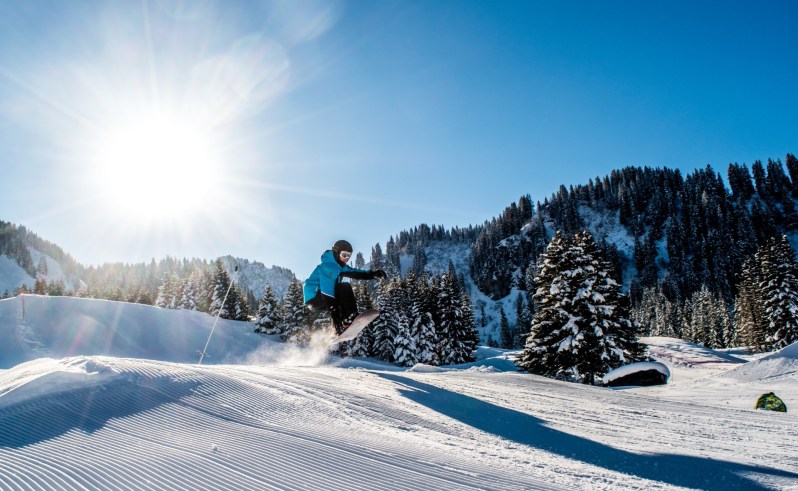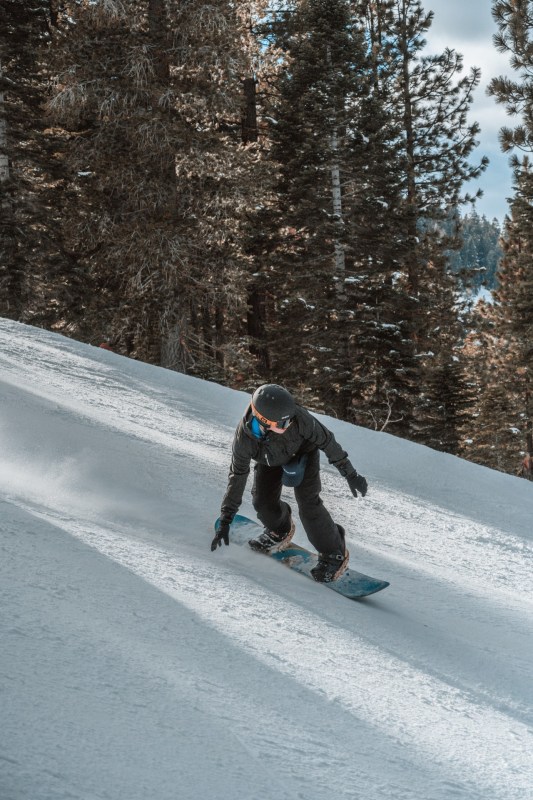
For the best snowboarding experience, you need the right tool for the job. That means riding a board tailored to your abilities and style to get the most out of every turn, slash, and pop. Central to a snowboard’s performance is its flex.
Referring to the ability to bend lengthwise and torsionally, a snowboard’s flex pattern produces varying ride characteristics. Picking the right kind — whether stiff, soft, or medium — makes all the difference when you ride down the hill.
Here’s how to gauge different board flexes while shopping and which types suit particular riding styles. Let’s dive in.

Why snowboard flex ratings matter
Whether playing a sport or driving a car, you need hardware suited to your needs. If you’re a performance driving enthusiast, you want a focused sports car like a Porsche 911 GT3, not a comfortable cruiser like a Toyota Avalon. Or, if you jog for enjoyment — not setting personal bests — you want a max cushion trainer, not a racing flat.
The same holds for snowboards. Soft flexing boards are playful, bending and flexing with the terrain, offering forgiveness and fun. On the other hand, stiff boards are ready to rip for hard-charging turns and energetic pop but can be a challenge to ride. Here’s how to wade through all the options.

How to test snowboard flex ratings in-store
Visiting snowboard shops is always a thrill. Letting you play kid-in-a-candy-store, they offer wall-to-wall gear that dazzles the senses. But with so many options, selecting the right board takes a measured approach.
If you’re feeling unsure, ask a salesperson to point out varying board types — freestyle, powder, and freeride — and associated flex ratings — soft, medium, and stiff. Then, it’s time to feel out each one.
Stand the board on its tail and grab the tip. Then, using your other hand, forcefully press into the middle of the board. A soft board willingly bends and twists for an easygoing feel. A stiff board resists and snaps back, showing its ability to carve and pop. A medium deck falls somewhere in between.
Soft-flexing snowboards: mellow performance for new riders
Beginners should go with a soft board for a relaxed, forgiving ride. You can make mistakes and keep going, all the while progressing your skills. At this point, you’ll mainly stick to easy green circle trails with some intermediate blue squares mixed in. As a beginner rider, you’re still developing a riding style — like freeride or freestyle — as you feel out new sensations.
Medium-flexing snowboards: increased response for progressing your skills
Intermediates can venture into medium flexing rides for a little more pop-off of side hits and hold while turning. With time, you’ll learn how the board responds to various inputs — like tilting and twisting — and hone your control and skill. Now, with your advancing skill set, you can handle greens and blues while testing the waters of black diamonds. At this point, you might start favoring a more freeride-oriented riding style (like ripping natural terrain) or a freestyle-oriented one (park, rails, and aerials), and a medium flexing board can handle either.
Stiff-flexing snowboards: ripping performance for advanced riders
Once you’re fluent in how to turn, jump, and stop, a stiff snowboard maximizes your abilities. Offering instant response and muscular performance, a firm-flexing board is like a track-tuned sports car. You can ride any trail — whether a mellow groomer or harrowing chute — with your every input translated into hard-charging performance. Advanced riders can ride anything and everything, whether big-mountain steeps or giant park features. A stiff board provides stability and response when charging down the hill.

Take your time picking the right snowboard flex
We get it. It’s exciting to see a sweet board with popping graphics and a sinewy shape. But if it isn’t the right flex for your ability, you won’t enjoy your time on the hill. Be honest with yourself. Flex as many decks as you can in-store and get a feel for how each responds. If the shop lets you, put on some boots, mount the bindings, and strap in (or step on) for even more flex testing.
A snowboard’s flex is the leading indicator of its on-hill performance. Ranging from soft to stiff and everything in between, snowboard flexes suit varying abilities and terrains. When you visit the shop, hand flex each board, be honest about your skill level, and you’ll walk away with a deck that suits you to a T. Then you can have a blast all winter.



